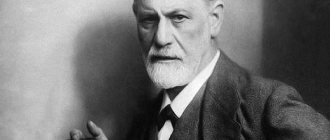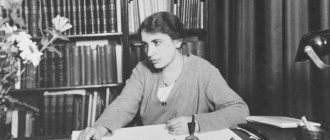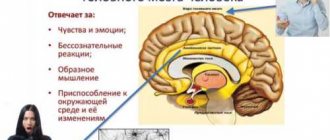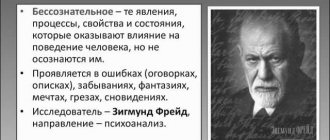Great minds have been studying the human psyche for decades, but many questions still have no answers. What is hidden in the depths of a human being? Why do events that happened once in childhood still affect people to this day? What makes us make the same mistakes and hold on to hateful relationships with a death grip? Where do dreams originate, and what information is contained in them? These and many other questions regarding the mental reality of man can be answered by the revolutionary psychoanalysis, which has corrected many of the fundamentals of psychology, created by the outstanding Austrian scientist, neurologist and psychiatrist Sigmund Freud.
What is psychoanalysis
Psychoanalysis is a theory founded by Sigmund Freud, as well as a method for eliminating psychological problems.
When developing the theory, the famous Austrian psychotherapist used many years of experience gained during his medical practice.
So, what do the basic principles of psychoanalysis say?:
- Conflicts between the conscious and unconscious can lead to neuroses, fears, depression and other mental disorders.
- A person’s experience, knowledge and behavior are formed on the basis of his irrational unconscious drives.
- An individual trying to realize these drives “turns on” defense mechanisms that interfere with the process of awareness.
- The influence of the unconscious can be neutralized through its awareness. Psychoanalysis is a therapy that involves solving a problem.
The key idea of psychoanalysis comes down to the statement that a person is not aware of his own motives for behavior - they need interpretation. According to Freud's classical psychoanalysis, the patient should voice all his thoughts, associations, and dreams. The task of a psychoanalyst is to analyze what he hears.
History of psychoanalysis
The history of psychoanalysis dates back to 1880, in the days when the Viennese physician J. Breuer shared with his comrade S. Freud a remarkable story about a patient who was cured of the symptoms of hysteria after a hypnosis session. At the reception, she was able to voice a deeply traumatic event that happened to her. The result was a strong emotional reaction. Catharsis resulted in a significant reduction in symptoms. When the patient emerged from the hypnosis state, she had no memory of her confessions.
Freud decided to apply the technique with his patients - Breuer's results were confirmed. The partners shared their findings in a joint publication, Research on Hysteria, arguing that the symptoms of hysteria are caused by repressed memories of traumatic events. The difficult situation is repressed from consciousness, but continues to influence the patient.
Personal reasons prompted Breuer to withdraw from research and Freud began independent work. He was able to discover that a similar result is achieved not only with hysteria, but also with obsessive states of a sexual nature, often arising in childhood.
The psychoanalyst initially considered the Oedipus complex to be the key cause of neuroses. The symptom begins to form at moments when the child’s unconscious drives threaten to break through the barrier set by repression, which turns out to be unacceptable for other parts of the psyche due to fear of punishment and for moral reasons.
Basics of psychoanalysis
Psychoanalysis is a therapy based on several immutable principles:
- First of all, the principle of determinism is implied. According to the ideas of psychoanalysis, not a single manifestation of the psyche can be called random, unrelated to anything, or involuntary. Conscious feelings, thoughts, impulses should be considered as events of cause-and-effect interactions determined by early childhood experience. Special research methods (mainly through dream analysis and associations) reveal the connection between situations from the past and current psychological experience.
- The basis of the second principle was the topographical approach. All mental elements are assessed according to the criteria of their accessibility. Repression, which ensures the removal of certain psychological elements from consciousness, indicates that a certain part of the psyche is making efforts without wanting to realize them.
- The third dynamic principle is based on the theory that the psyche is driven to action by impulses of aggression and sexuality, which are elements of a common biological heritage. They have significant differences from the instinctive behavior of animals. In the animal world, a stereotypical response is usually recorded, provoked by special stimuli in certain situations and aimed at survival. Psychoanalysis considers attraction as a state of nervous excitement, which is a response to stimuli that direct the psyche to action and relieve tension.
- The fourth principle is the genetic approach. The personality traits of an adult, characterizing his conflicts and neurotic symptoms, are generally associated with the fantasies and desires of childhood. It is believed that no matter what paths open to a person, he will not be able to escape from his own childhood experiences - in any case, they will haunt him throughout his life.
Methods of psychoanalysis
Let us consider in detail the main methods used in the field of psychoanalysis: the method of dream interpretation, the method of free association, the method of interpretation. Let's describe each one separately.
Free association method
What is this famous method based on? On the use of the phenomenon of associative thinking in order to study deep mental phenomena and processes (often they are unconscious). The data obtained are used for the treatment and correction of functional mental disorders, with the help of the patient’s awareness of the nature and source of the problems.
What is special about the free association method? In a conscious joint and purposeful confrontation between the therapist and the patient with a state of psychological discomfort. Acting together, the psychoanalyst and the patient cope with the problem.
The method of free association can be called a method for studying the mental state of a patient. He talks about any thoughts that come into his head, no matter how absurd or inappropriate they may seem. They may sound fantastic, ordinary, obscene. The therapist has to draw a conclusion from these revelations or incoherent fragments of thoughts.
In the “Dictionary of Psychoanalysis” (J.B. Pontalis, J. Laplanche) it is noted that free associations can be called the expression of all indiscriminately ideas and thoughts that arise in the mind - spontaneously or starting from any element (number, word, image from a dream).
Freud called for abandoning the role of controlled consciousness, beginning to understand mental processes. He stated that consciousness tries to eliminate images and thoughts that appear on the periphery before the attention of the analyzing object is focused on them. Moreover, when analyzing the mental state, it is these images and thoughts that can carry special meaning.
It was Freud who first began to actively use the method of free association. The psychoanalyst suggested that his patients lie down on the couch and relax, simply saying whatever came to their mind, no matter how incredible, absurd and unusual these thoughts were from the point of view of usual moral standards. During the sessions, the therapist observed how powerful emotional drives led uncontrolled thinking to mental conflict. The famous psychotherapist stated that the first random image and thought implies exactly what is needed for psychoanalysis. A random thought may have a connection to a repressed memory.
Dream interpretation method
According to the theories of Sigmund Freud, dreams can reveal the presence of intense mental activity in the depths of consciousness. What is dream analysis? The therapist must find the distorted unconscious truth hidden in every dream. Freud was convinced: the stranger and more confusing the dream, the more hidden content it contains. In the language of psychoanalysis, this phenomenon is called resistance - its manifestations can be noticed even when the person who saw the dream does not agree to its interpretation. This speaks of his unconscious resistance, established barriers to protect his own psyche.
Dreams separate the unconscious from the real world. In them, exciting situations that cause emotions are deformed in the most bizarre way. Dreams can also tell about secret desires. In the case of child psychoanalysis, the differences between hidden and overt thoughts are less clear.
Hidden thoughts are transformed into symbols, appearing in a form acceptable to consciousness. This allows them to bypass certain "censorship". Even today, the manifestation of the unconscious in the form of dreams remains one of the greatest mysteries of consciousness.
The method of dream interpretation is very important - it allows you to identify the essence of the images that appear in a dream. Freud processed dreams by positioning them as symptoms of illness. According to him, for the correct use of this method, it is not recommended to consider dreams as something single - such an analysis will not lead to anything worthwhile. He was convinced: when analyzing dreams, it is necessary to painstakingly study its elements separately. The association rule should be applied to individual fragments. Freud considered any dream not only an object worthy of scientific research, but also a way to know one’s deep essence, to discover hidden desires that do not appear on the surface.
Interpretation method
Interpretation is considered one of the most important tools of any analyst. Even in the interpretation of dreams and free associations, interpretations are used by the therapist. What does this term mean?
Interpretation is called the main analytical tool. In dream interpretation and free association, the psychoanalyst attempts to use interpretations. We are talking about transferring significant information about the patient from the unconscious level to the conscious level. Repressing information that causes concern and anxiety in an individual, as well as its correct analysis, will soften the symptoms of neurosis or other mental problems.
Basic concepts and ideas of Freudianism
Psychoanalysis
(from the Greek psyche - soul and analysis - decision) - part of psychotherapy, a medical research method developed by S. Freud for diagnosing and treating hysteria. Then it was reworked by Freud into a psychological doctrine aimed at studying the hidden connections and foundations of human mental life.
This doctrine is based on the assumption that a certain complex of pathological ideas, especially sexual ones, is “repressed” from the sphere of consciousness and operates from the sphere of the unconscious (which is thought of as the area of domination of sexual aspirations) and under all sorts of masks and vestments penetrates consciousness and threatens spiritual unity I, included in the world around him.
In the action of such repressed complexes
“they saw the cause of forgetting, slips of the tongue, dreams, false actions, neuroses (hysteria), and they tried to treat them in such a way that during a conversation (“analysis”) it was possible to freely evoke these complexes from the depths of the unconscious and eliminate them (through conversation or appropriate actions), namely to give them the opportunity to react.
Proponents of psychoanalysis attribute sexual (“ libido
") a central role, considering human mental life as a whole as a sphere of dominance of unconscious sexual desires for pleasure or displeasure.
Psychoanalysis in psychology and philosophy
One can hear many general statements about psychoanalysis. It is usually noted that psychoanalysis is a well-known direction in psychology, the benefits and significance of which are assessed differently. The method has both supporters and opponents.
If we talk about psychoanalysis in a philosophical vein, it is noted that a feature of psychoanalytic concepts is their connection with psychotherapeutic practice. It is not reduced to either experimental knowledge or philosophical speculation, but grows from the experience of communication and other aspects. Real comprehension of your inner world is achieved through insight. Such insight brings changes to the patient’s life - he begins to think about himself and his beliefs in a completely different way.
This philosophy is somewhat similar to ancient teachings that combined the theory and practice of Zen Buddhism, yoga and other types of mental self-regulation.
The practice of psychoanalysis is periodically compared with the healing actions of priests and shamans. Training in psychoanalysis is equated to initiation. It is no coincidence that many famous analysts who practice psychoanalysis simultaneously show interest in various Eastern teachings and even magic.
Most adherents of Freud's theories, as before, adhere to the model of the human psyche that was supported by the “father of psychoanalysis.” Their beliefs are based on the fact that psychoanalysts usually receive psychological or medical training. Their task is to adapt the patient to surrounding circumstances. To a large extent, psychoanalysis is widespread in America and the most developed European countries.
At one time, Sigmund Freud still hoped that his theories of psychoanalysis would be recognized by the scientific community. For this purpose, he resorted to analogies with archeology, hydraulics, economics and other sciences. Gradually, the conviction began to grow stronger in him that this would not happen after all.
The first reason can be called the difference in approaches, and the second is that for scientists, whose formation took place in the scientific fields of the nineteenth century, psychoanalysis is an unacceptable aspect for personal reasons. The ideas of therapy ran counter to narcissistic illusions about the power of the mind over nature and oneself. In general, the frequency with which many representatives of science and philosophy condemned the principles of psychoanalysis indicates their obvious bias. Gradually these beliefs began to change.
Today, the scientific status of psychoanalysis periodically continues to be challenged. Some researchers are inclined to think that it is still scientific, others question this statement, calling the well-known therapy pseudoscience.
However, in the twentieth century, psychoanalysis became widespread in the humanities, psychology, philosophy and other fields.
Summarizing
Freud's theory of psychoanalysis was briefly and clearly presented in this article. To summarize, we can say that this method is one of the attempts to understand those features of the human psyche that were previously incomprehensible . In the modern world, the term “psychoanalysis” is used in the following areas:
- As the name of a scientific discipline.
- A collective name for a set of events dedicated to research into the functioning of the psyche.
- As a method of treating neurotic disorders.
Many modern scientists often criticize Sigmund Freud's theory. However, today, the concepts that were introduced by these scientists are a kind of basis for the science of psychology.
Freud's theory of psychoanalysis: briefly
According to Freud's theory, the human psyche can be “divided” into the following components: Ego, Id and Superego.
Definition of terms:
- The id is the main source of drive and desire. As an analogy, we can cite an ordinary street dog, where all its actions, such as mating, sleeping, etc., are the result of instincts inherent in nature.
- The ego is a mediator that divides social frameworks and animal instincts. The part of the personality that satisfies the needs of the id, taking into account the limitations of the external world.
- The superego implies all social frameworks, starting with the period of parental education, when the foundations are laid for what can be done and what is unacceptable. In adult life, it is reflected in all aspects of life, such as morality, religion, law.
The topical model of the mental apparatus includes two elements: the unconscious and the conscious.
What do they mean:
- The unconscious is psychic forces that are below the level of consciousness. They determine how a person behaves.
- Conscious is a mental aspect that an individual is able to become aware of. Consciousness has a direct impact on how an individual positions himself in society. The psyche can automatically be corrected by the pleasure principle. If the balance is disturbed, then a reset occurs through the unconscious sphere.
Defense mechanisms realize the conflict between the Superego and the Id. Freud described many of them: isolation, projection, repression, denial, substitution, regression and so on.
Video
Real Chinese Milk Oolong Tea Green Leaf Ceremony (Milk Oolong Tea, Nai Xiang Jin Xuan, Golden Flower with Milk Aroma, Turquoise Tea), Light Milk Taste, 200 g.
389 ₽ More details
Real Chinese Milk Oolong Tea Green Loose Leaf Ceremony (Milk Oolong Tea, Nai Xiang Jin Xuan, Golden Flower, Turquoise Tea), Subtle Natural Taste, 100 g.
237 ₽ More details
Medical tweezers
Classic psychoanalysis by Sigmund Freud
Having begun to develop a new approach to the treatment of mental problems, Freud initiated his own research and studied the data of other scientists. Nowadays the theory of psychoanalysis is considered truly unique. What distinguishes her from others is that she does not undertake to study individual problems of an individual. Psychoanalysis looks at everything in its entirety. We suggest that you briefly familiarize yourself with the main provisions of therapy.
Classical psychoanalysis is based on the determinism of the biological component - on the assertion that physiological needs suppress all others and indicate their vector. Mental determinism indicates that any incident in a person’s life has its consequences. Each of his actions is determined by an obvious or hidden motive, which was preceded by certain events.
Several aspects of an individual’s mental life are distinguished: conscious, preconscious, unconscious. In the first case, we are talking about experiences and current thoughts, in the second – about secret desires and fantasies, in the third – about what stands out from consciousness, suppressed by the internal censor. Freud believed that psychology should be interested in this complex mechanism in detail.
Defense mechanisms of the psyche
Projection is a way of transferring one's own feelings and secret desires to another animate or inanimate object. For example, a prude is a person who hides true sexual desires and looks for the slightest dirty intentions in the actions of others.
As for inanimate things, these are examples of situations in which a person endows objects or phenomena with his experiences. For example, a menacing sky, a disturbing sculpture, harmful alcohol, etc.
By the way, there are diagnostic techniques based on projections. For example, a hand test, in which the participant is shown drawings of a hand, and he gives his associations and feelings from what he saw.
Repression is the suppression and removal from the conscious part of the psyche of unacceptable and personality-threatening thoughts, images and memories. An example would be a strong shock such as the death of a person, a disaster, or a change in one’s zodiac sign.
A person often does not remember the details and key moments of a given event. Despite the fact that the content of the repressed motive is not realized, the emotional component continues to manifest itself in different forms.
Having defined the fundamental foundations on which Freud's theory is built, we can consider in more detail the concept of psychoanalysis as a branch of the science of psychology.
The techniques used by psychoanalysis are free association, dream interpretation, interpretation, resistance and transference analysis. All of them are aimed at working with the unconscious and bringing unconscious processes into the conscious area.
When this happens, the negative symptoms disappear.
For example, during attacks of fear and uncontrollable anxiety, a person is not aware of their cause and tries to find a rational explanation. In this example, along with repression, such a protective mechanism of the psyche as rationalization works. To identify and define unconscious processes in the brain, Freud asked patients to talk about free topics.
As a rule, repressed processes manifest themselves in the form of neurotic symptoms: slips of the tongue, misspellings and awkward movements.
Psychoanalysis of modern times
Sigmund Freud was convinced that all our actions are dictated by subconscious desires. Particular emphasis was placed on the fact that emerging needs are based on physiology and sexual desires. Modern psychology no longer focuses on this and does not pay too much attention to the statement.
How widespread is psychoanalysis today? In many countries it is quite developed, being quite an ordinary phenomenon. Many modern therapists write books on this topic, which are very popular - that is, it is in demand. Of course, a certain type of society has long resisted the principles of psychoanalysis, not accepting them. This can be said about Germany during the period of National Socialism and the USSR before the Brezhnev stagnation. These examples are the most obvious. Both the fascist and communist regimes opposed Freud's teachings on ideological grounds. The Germans considered these theories “Jewish science that degrades human dignity,” and the Soviet Union considered these theories “the apotheosis of bourgeois individualism.”
Both hidden attempts to oust the teaching from the life of society and obvious repressions against it are known. It is worth recognizing that psychoanalysis also runs counter to many religion-centered and theocratic societies. Although there are cases when it was successfully developed in countries with authoritarian political regimes. The most obvious example is Argentina. According to the assumption of the Argentine psychotherapist A. Benjamin, the reason is that it was the psychologist’s office that usually became the last refuge for oppressed citizens, where freedom of speech was not prohibited.
To summarize, the conclusion suggests itself that freedom is considered the main condition for the successful development of psychoanalysis in society. Let us clarify that in this case, society should share the value of freedom, it should demonstrate the real implementation of freedoms (personality, speech, thought). By the way, for the full development of psychoanalysis, freedom of association is required, which makes it possible for the corresponding community to take shape.
In general, psychoanalysis is quite common in modern society. Various trainings are conducted, therapeutic rooms operate, and relevant literature is published.
Psychoanalytic philosophy of S. Freud
1. Non-classical philosophy: essence, reasons for its appearance
Non-classical philosophy appeared in the second half of the 19th and early 20th centuries, which was caused by the crisis of Western civilization and culture, the loss of faith in the possibility of improvement of society and man. In Europe there were endless wars, uprisings and revolutions, famine and epidemics raged, and economic crises occurred. One got the impression that a person is powerless to solve his problems intelligently.
| Classical philosophy | Non-classical philosophy |
| 1. The main feature is rationalism. Rationalism is a philosophical doctrine based on faith in the rational and natural structure of the world, in the ability of the human mind to understand the world and improve it. 2. The goal of classical philosophy is to create comprehensive teachings that explain the whole world, to discover the most general laws of nature, society, and knowledge. | 1. The main feature is irrationalism. Irrationalism is a philosophical doctrine that has lost faith in the logical structure of the world, the possibility of its knowledge and improvement, in the rational nature of man. 2. The purpose of non-classical philosophy is to study the essence of man, the problems of his existence in an unreasonably structured world. |
2. Voluntarism and pessimism of A. Schopenhauer
The teachings of the German philosopher Arthur Schopenhauer (1788-1860) are called voluntarism , since, in his opinion, the first principle and the ruling force of the world is will . This is a kind of unconscious world, universal force that does not have any reasonable goals, causing struggle and competition in inanimate and living nature . In modern language, will is energy . In man, as in other living beings , it manifests itself as the will to live . It seems to a person that he acts guided by reason. In fact, the unconscious will to live makes it its slave, since it forces us to live at all costs, to cling to life, even if it is difficult or even unbearable.
All human life is suffering and disappointment. The will makes a person strive for unreasonable goals. First of all, it makes you desire material values: wealth, power, fame, etc. But even if a person manages to achieve something, it does not bring him happiness, he experiences disappointment, feeling the unimportance of what he has achieved, indifference and boredom set in. A short human life rushes between suffering and boredom. There is struggle and fierce competition in society. The world is filled with evil, meaninglessness and unhappiness, it is the worst possible world. Schopenhauer calls his teaching pessimism . Pessimism (from the Latin “pessimus” - the worst) is the tendency to see only the bad in everything, disbelief in a better future . Schopenhauer is considered the most pessimistic of all pessimistic philosophers.
A person must get out of the grip of the unconscious will to live, learn to live truly intelligently, control his desires, cultivate indifference to suffering, and compassion for others. To do this, he must rise above the level of everyday existence and understand the general structure of the world. The means of understanding the world and self-improvement are philosophy and art.
3. “Revaluation of Values” by F. Nietzsche
The German philosopher Friedrich Nietzsche (1844-1900) gained fame thanks to his reassessment of the values underlying Western civilization. He accepted Schopenhauer's idea of the World Will as a universal driving force. Schopenhauer called the manifestation of the World Will in living beings the “will to live,” and Nietzsche called the “will to power.” The will to power is the desire for self-affirmation and dominance. Life is a struggle of wills to power. Everything that strengthens the will to power, promotes survival and biological prosperity is valuable.
From the standpoint of this approach, Nietzsche criticized the values of democracy and Christianity. He convincingly showed how the democratic principle of equality and Christian ethical standards of love and mercy are gradually leading Western civilization to stagnation, degradation, decline in cultural level and, ultimately, degeneration. The principles and values of democracy and Christian morality correspond to the interests of weak, mediocre people, gray and mediocre, incapable of creating cultural values, engaged only in their consumption. It is for this type of people that favorable living conditions have been created in the West, while everything bright and talented is doomed to death due to envy and misunderstanding by the aggressive gray majority.
Nietzsche believed that the true structure of society should be based on the recognition of the inequality of people in personal qualities and merits. More correct and progressive is not a democratic (the power of the people), but an aristocratic (the power of the best) structure of society, in which power belongs to charismatic people, smart, energetic, strong-willed, active.
Nietzsche's philosophy is imbued with disgust for man. In his opinion, modern man for the most part is a super chimpanzee, that is, in fact, just a cunning animal, since he lives mainly by animal needs and pleasures. Humanity is degenerating. In its place, over time, a new biological species will arise - a superman. There will be the same difference between him and a man as there is now between a man and a monkey. The superman is a noble nature striving for cultural progress, improvement of the individual and society. Material values and well-being are not the goal of his life. According to Nietzsche, only in the appearance of the superman lies the justification of existence, the meaning of life for humanity. Man is not the “crown of creation,” but only an intermediate link in biological evolution, which will continue.
4. Psychoanalytic philosophy of S. Freud
The Austrian psychiatrist Sigmund Freud (1856-1939) radically changed the concept of man. Freud is the founder of psychoanalysis . Psychoanalysis is a psychological doctrine and method of treating mental disorders, based on the recognition of the existence in the psyche of such a part as the unconscious and its influence on human life.
Before Freud, man was considered a 100% conscious being who is aware of all his actions, can take control of them and be the true master of his character and destiny. Freud established that the layer of consciousness in the psyche is thin and fragile, and beneath it there is a much more voluminous layer of the unconscious. The relationship between the conscious and unconscious parts of the psyche, according to Freud, is the same as between the surface and underwater parts of an iceberg. In the unconscious part of the psyche, a much larger amount of information is stored, processed and used to regulate behavior than in consciousness. The unconscious determines a large part of our actions, for which we only come up with plausible explanations in hindsight.
The main structural units of the unconscious are instincts - the body’s innate reactions to internal and external stimuli. Having analyzed innate instincts, Freud came to the conclusion that they are mostly immoral in nature. These are the instincts of selfishness, aggression, the desire for power, excessive sexuality, laziness, etc. Thus, Freud confirmed the correctness of medieval philosophers who considered man a sinful and vicious being by nature. Accordingly, the philosophers of the Enlightenment were mistaken in believing that a person is born good and blameless, and only life in an imperfect society spoils him. In fact, a person is immoral from birth, and only in the process of socialization does he learn to control his innate instincts and get along with others.
When innate instincts collide with cultural prohibitions, moral norms, and religion, a person experiences acute negative emotions. In an effort to avoid their traumatic effects, a person displaces them from the sphere of consciousness into the unconscious. Suppressed negative emotions poison a person’s existence, causing physical and mental diseases such as asthma, stomach ulcers, impotence, neurosis, hysteria, etc. Freud attached particular importance to unsatisfied sexual instincts. Thanks to Freud, it became possible to study and discuss the problems of sexual life, the concepts of “Oedipus complex”, “castration complex”, etc. became famous. From the position of a doctor, concerned about the spread of mental disorders in modern society, Freud spoke out for the liberalization (softening) of cultural sexual morality, suppressive sexual instincts. Therefore, Z. Freud is considered the ideological inspirer of the sexual revolution of the 60-70s. XX century
Thus, the ideas of A. Schopenhauer and F. Nietzsche shook the faith in the rational structure of the world and society, and the psychoanalysis of Z. Freud shook the faith in the rationality of man.
Topic 9. Philosophy of the 20th century
Existentialism
Philosophical ideas of feminism
1. Existentialism
Existentialism (from the Latin “existence” - existence) is one of the main trends in philosophy of the 20th century. In the first half of the century, the idea of man’s ability to improve society with the power of his mind finally collapsed. Instead of the advent of an era of universal prosperity, justice, and brotherhood, two world wars broke out, the revolution of 1917 and the civil war in Russia, the fascist regime in Germany and Stalin’s in the USSR, etc. social phenomena . The philosophy of existentialism has become an attempt to understand the problem of how a person can survive in a situation of acute social crisis, the collapse of habitual systems of values, norms, stereotypes of thinking and action, when a person is on the verge of life and death . The most famous representatives of existentialism are the French philosophers Jean Paul Sartre (1905-1980) and Albert Camus (1913-1960).
The wide range of existentialist ideas can be reduced to a few basic ones.
The idea of the absurd . According to existentialists, it is pointless to comprehend the world, since the world is dominated by absurdity, i.e. lack of meaning. It seems to a person that the world is reasonably structured, that there are some general laws of the world, history, and culture. In fact, blind passion, stupidity and evil reign in the world, turning it into absurdity and nonsense. The world evokes feelings of confusion, despair, and disgust in a person. “I am sick, therefore I exist,” this is how the existentialists adapted Descartes’ famous phrase.
The idea of existence . The subject of the study of philosophy is not the meaningless world, but man, his existence - existence. Existence refers to the life of a specific person. Moreover, not external, objective-material life (who works, how much he receives, what he has, etc.), but exclusively internal, spiritual life, the world of a person’s thoughts and experiences. “A person is filled with existence, like a football with air.” It is in this inner, spiritual world that a person can and should look for support for survival in the world of absurdity, since he can easily be deprived of all external supports (money, family, position in society, etc.) during social upheavals.
The idea of freedom . The main characteristic of existence is freedom. Man, of course, does not have absolute freedom; he depends on many natural and social factors. A person is free in the sense that his life, his actions are not programmed by God, genes or upbringing ; he decides for himself what to do in a given situation, and therefore it is difficult to predict his actions. A person himself writes the script of his life and fills it with meaning. Man is a constantly unfinished project; he constantly constructs and invents himself, and in this internal creative activity he is free.
Idea of choice . Freedom constantly confronts a person with the need to choose. A person must always choose one or another form of his behavior, focus on certain values, norms and ideals. Moreover, there are no sufficient grounds for choice, there are no universal, general and only correct guidelines. When making decisions, a person cannot confidently rely on Christian or other morality; everything is relative, nothing indicates how to act correctly.
The idea of personal responsibility . Having made a choice, a person bears personal responsibility for it and cannot shift it to other people or circumstances. “There is no alibi for a person,” that is, there are no excuses. A coward is responsible for his cowardice, a traitor is responsible for his betrayal. A person cannot say: “What could I do? I had no choice". There is always a choice. The only question is about the price of choice, which can be quite high, sometimes even equal to life. And not always a person is ready to pay a high price. By choosing certain values and ideals, doing certain actions, an individual shapes himself as a person and at the same time predetermines the future of the world.
The ideas of existentialists are of a pronounced ethical nature, they mobilize people to form an active life position, reject any justification for their actions by external or internal factors, and realize their responsibility for personal and public life.
2. Philosophical ideas of feminism
Feminism is a movement of women against discrimination based on gender. The famous representative of feminism, Simone de Beauvoir (1908-1986), critically assessed the social status of women. She argued that European culture is dominated by men's self-esteem as the first, superior sex and the assessment of women as the second, and in essence, second-class sex. A woman has long been considered an inferior and dependent creature, inferior in comparison to a man, limited and weak, whose whole meaning of life is to serve a man and be useful to him. Her role in society was to be a wife and mother. The woman was denied the ability to think and the status of a citizen; she was excluded from public life (she did not work in the civil service, did not have voting rights, etc.). Sphere of decision making, inheritance, etc. – everything was the prerogative of the man. This discounted status of women in a weakened version is still preserved, it is declared given by nature and therefore unchangeable, it is imposed on women, and they come to terms with it. “Anatomy is destiny,” S. Freud expressed the male position. As a result, women, compared to men, have significantly less freedom to individually choose the forms of their lives.
Objecting to Z. Freud, S. de Beauvoir, in the spirit of the ideas of existentialism, argued that there is no biological programming of man. “One is not born a woman, one becomes one,” she said. A child becomes a man or a woman depending on what social behavior programs are instilled in him and how he is raised. Changing the status of women in society requires that both men and women come to a new and more equal understanding of themselves and each other. The equality of the sexes that feminists defend does not mean their sameness, but legal, material and social equality. Women should have the full right and opportunity to decide for themselves what type of activity they want to engage in, whether to start a family, whether to have children, etc. Society must get rid of such stereotypes as “this is not a woman’s business” or “this is not a man’s business.” A person’s status in society should be determined by personal qualities and merits, and not by gender or anatomy. The natural fundamental difference between the sexes should be assessed not in terms of “superior-inferior”, but in terms of complementarity.
In many countries, women have achieved de jure equality and are now fighting for de facto equality. Belarus, according to the World Bank, ranks 23rd in the world in terms of gender equality out of 128 possible.
Topic 10. Philosophy of Russia and Belarus











